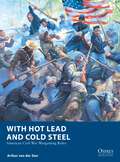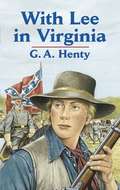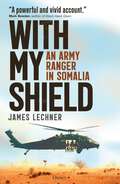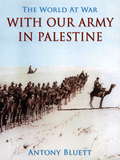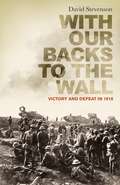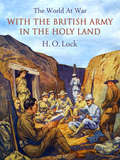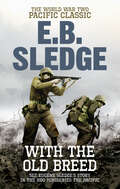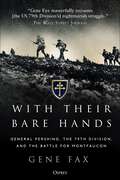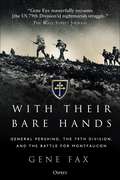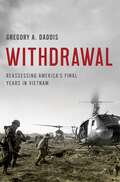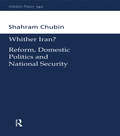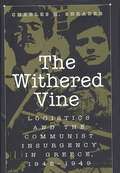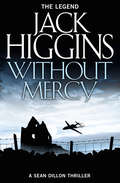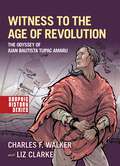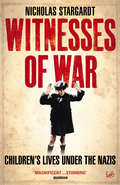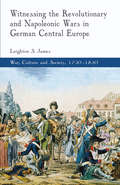- Table View
- List View
With Hope and Love (The Cliffehaven Series #17)
by Ellie Dean**************PRE-ORDER NOW:THE SEVENTEENTH CLIFFEHAVEN NOVEL BY SUNDAY TIMES BESTSELLING AUTHOR ELLIE DEANCliffehaven, 1945The war in Europe is over, but for Peggy Reilly and the residents of Beach View Boarding House the effects of the conflict are still far-reaching.Cockney evacuee, Ivy, and her sweetheart, Andy, are saving to get married and fulfil their dream of returning to the East End. But when tragedy strikes, Ivy is faced with a life-changing dilemma that only she can resolve.Rita also faces an impossible choice when her sweetheart Peter proposes and asks her to live with him in Australia – just as her widowed father returns from the fighting in Europe.Meanwhile Peggy must say goodbye to several of her evacuee chicks whilst she awaits the return of her family from Somerset and the news that her husband, Jim, can finally come home.It’s a dream she’s held onto for six long years, but fate has one more twist in store.
With Hot Lead and Cold Steel: American Civil War Wargaming Rules (Osprey Wargames #32)
by Arthur van SterA set of wargaming rules for fighting large battles set during the American Civil War.From the First Bull Run to Appomattox Court House, enter one of the defining conflicts of American history. With shot, shell, and sabre, guide the armies of the Blue and the Grey through this first modern war to determine the fate of a nation.With Hot Lead and Cold Steel is a large-scale, mass-battle wargame for recreating the American Civil War. Designed to handle brigade and divisional level engagements while providing a balance between ease of play and period detail, With Hot Lead and Cold Steel is ideal for new gamers and wargaming veterans alike. It contains everything players need to raise armies and craft scenarios, whether based upon historical campaigns and orders of battle or those of their own devising.
With Hot Lead and Cold Steel: American Civil War Wargaming Rules (Osprey Wargames #32)
by Arthur van SterA set of wargaming rules for fighting large battles set during the American Civil War.From the First Bull Run to Appomattox Court House, enter one of the defining conflicts of American history. With shot, shell, and sabre, guide the armies of the Blue and the Grey through this first modern war to determine the fate of a nation.With Hot Lead and Cold Steel is a large-scale, mass-battle wargame for recreating the American Civil War. Designed to handle brigade and divisional level engagements while providing a balance between ease of play and period detail, With Hot Lead and Cold Steel is ideal for new gamers and wargaming veterans alike. It contains everything players need to raise armies and craft scenarios, whether based upon historical campaigns and orders of battle or those of their own devising.
With Lee in Virginia: A Story Of The American Civil War (The Land of Oz)
by G. A. HentyIn this spirited tale of adventure, Vincent Wingfield, who is not yet sixteen, returns home to Virginia after four years of school in England to find conditions in America greatly unsettled. When war breaks out in 1861, Vincent staunchly supports the rights of slaves but joins Lee's cavalry to fight for the Confederacy.Henty's gripping story, written several decades after the war, weaves the spirited teenager's adventures with real-life events, while providing an acute glimpse of the conflict from a Southern perspective.A prolific 19th-century author, G. A. Henty celebrates family, honor, loyalty, bravery, and determination in the face of adversity. Set against the backdrop of an exciting historical era, this story, recently rediscovered by young readers, will excite the imaginations of today's youngsters as much as it thrilled readers when first published.
With My Shield: An Army Ranger in Somalia
by James LechnerThis is the inside story of an Army Ranger, surrounded and outnumbered, fighting a desperate action on the ground during the Black Hawk Down raid in Somalia in 1993. In 1993 Lieutenant James Lechner, a member of the 3rd Ranger Battalion, was selected for a top secret special operations task force being sent to Mogadishu, Somalia, to capture the insurgent leader Mohamed Farah Aideed. In early October, after weeks on the ground and conducting a number of raids in the city, the Task Force is called upon to conduct a daring daylight mission into the heart of Aideed's territory. During the raid, following the initial dangerous fast rope insertion and subsequent capture of a group of Aideed's lieutenants, one of the Task Force Black Hawk helicopters is shot down and Lechner and his comrades are soon caught up in the fiercest combat involving US forces since the Vietnam War. In the middle of the hostile city, deep in the enemy's stronghold, the small group of Rangers and special operators now find themselves fighting not only to rescue the downed helicopter's crewmen, but also to save their own lives. This first-hand account tells the story of how these elite warriors were able to stand together and prevail against incredible odds. It gives the reader the perspective of an Army Ranger fighting on the ground, combined with professional military analysis, in a groundbreaking book that tells the complete story with never-before-revealed details.
With My Shield: An Army Ranger in Somalia
by James LechnerThis is the inside story of an Army Ranger, surrounded and outnumbered, fighting a desperate action on the ground during the Black Hawk Down raid in Somalia in 1993. In 1993 Lieutenant James Lechner, a member of the 3rd Ranger Battalion, was selected for a top secret special operations task force being sent to Mogadishu, Somalia, to capture the insurgent leader Mohamed Farah Aideed. In early October, after weeks on the ground and conducting a number of raids in the city, the Task Force is called upon to conduct a daring daylight mission into the heart of Aideed's territory. During the raid, following the initial dangerous fast rope insertion and subsequent capture of a group of Aideed's lieutenants, one of the Task Force Black Hawk helicopters is shot down and Lechner and his comrades are soon caught up in the fiercest combat involving US forces since the Vietnam War. In the middle of the hostile city, deep in the enemy's stronghold, the small group of Rangers and special operators now find themselves fighting not only to rescue the downed helicopter's crewmen, but also to save their own lives. This first-hand account tells the story of how these elite warriors were able to stand together and prevail against incredible odds. It gives the reader the perspective of an Army Ranger fighting on the ground, combined with professional military analysis, in a groundbreaking book that tells the complete story with never-before-revealed details.
With Our Army in Palestine (The World At War)
by Antony BluettA fascinating book by a British soldier who tells of the efforts in WWI in the Middle East. This was a time when much of the battling was with bayonet and face to face. There are a lot of interesting facts of the brutality of that war. Toward the end he mentions that 60,000 people died of starvation in 'Beyrout' during the War out of a population of 80,000. (Excerpt from Goodreads)
With Our Backs to the Wall: Victory and Defeat in 1918
by David StevensonFINANCIAL TIMES HISTORY BOOK OF THE YEAR and DAILY TELEGRAPH BOOKS OF THE YEARShortlisted for the 2012 DUKE OF WESTMINSTER MEDAL FOR MILITARY LITERATUREAt the end of 1917 Britain and France faced a strategic nightmare. Their great offensives against Germany had been calamitous, leaving hundreds of thousands of young men dead and wounded for negligible territorial gains. Despite America's entry into the war the US army remained tiny, the Italian army had been routed, and Russia had dropped out of the conflict. The Central Powers now dominated Central and Eastern Europe, and Germany could move over forty divisions to the Western Front. Yet only one year later, on 11 November 1918, the fighting ended in a decisive Allied victory. Stevenson's rich and compelling book retells the story of 1918, and with penetrating original research goes to the very roots of this instrumental turning point in modern history.
With Our Backs to the Wall: Victory and Defeat in 1918
by David StevensonWith so much at stake and so much already lost, why did World War I end with a whimper-an arrangement between two weary opponents to suspend hostilities? After more than four years of desperate fighting, with victories sometimes measured in feet and inches, why did the Allies reject the option of advancing into Germany in 1918 and taking Berlin? Most histories of the Great War focus on the avoidability of its beginning. This book brings a laser-like focus to its ominous end-the Allies' incomplete victory, and the tragic ramifications for world peace just two decades later. In the most comprehensive account to date of the conflict's endgame, David Stevenson approaches the events of 1918 from a truly international perspective, examining the positions and perspectives of combatants on both sides, as well as the impact of the Russian Revolution. Stevenson pays close attention to America's effort in its first twentieth-century war, including its naval and military contribution, army recruitment, industrial mobilization, and home-front politics. Alongside military and political developments, he adds new information about the crucial role of economics and logistics. The Allies' eventual success, Stevenson shows, was due to new organizational methods of managing men and materiel and to increased combat effectiveness resulting partly from technological innovation. These factors, combined with Germany's disastrous military offensive in spring 1918, ensured an Allied victory-but not a conclusive German defeat.
With the British Army in The Holy Land (The World At War)
by H. O. LockThe Holy Land has been the scene of war since the dawn of History. Long before Belgium became the cock-pit of Europe, Palestine was the cock-pit of the known world. Here, on the high road between Asia and Africa, were fought the great wars of Egyptians and Assyrians, Israelites and Canaanites, Greeks and Romans, Saracens and Crusaders. With these few square miles are associated the names of the world's greatest soldiers no less than that of the Prince of Peace. None can fail to be interested in the latest campaign in this Land of Armageddon. (Goodreads)
With the Old Breed: The World War Two Pacific Classic
by Eugene B SledgeThe inspiration behind the HBO series THE PACIFICThis was a brutish, primitive hatred, as characteristic of the horror of war in the Pacific as the palm trees and the islands...Landing on the beach at Peleliu in 1944 as a twenty-year-old new recruit to the US Marines, Eugene Sledge can only try desperately to survive. At Peleliu and Okinawa - two of the fiercest and filthiest Pacific battles of WWII - he witnesses the dehumanising brutality displayed by both sides and the animal hatred that each soldier has for his enemy.During temporary lapses in the fighting, conditions on the islands mean that the Marines often can't wash, stay dry, dig latrines, or even find time to eat. Suffering from constant fear, fatigue, and filth, the struggle of simply living in a combat zone is utterly debilitating.Yet despite horrendous conditions Sledge finds time to keep notes that he would later turn into a book. Described as one of the finest memoirs to emerge from any war, With the Old Breed tells with compassion and honesty of the cruelty, bravery and deaths of the men he fought alongside, and of his own journey from patriotic innocence to battle-scarred veteran.'Eugene Sledge became more than a legend with his memoir, With The Old Breed. He became a chronicler, a historian, a storyteller who turns the extremes of the war in the Pacific - the terror, the camaraderie, the banal and the extraordinary - into terms we mortals can grasp' Tom Hanks
With Their Bare Hands: General Pershing, the 79th Division, and the battle for Montfaucon
by Gene FaxWith Their Bare Hands traces the fate of the US 79th Division – men drafted off the streets of Baltimore, Washington, and Philadelphia – from boot camp in Maryland through the final years of World War I, focusing on their most famous engagement: the attack on Montfaucon, the most heavily fortified part of the German Line, during the Meuse-Argonne Offensive in 1918. Using the 79th as a window into the American Army as a whole, Gene Fax examines its mistakes and triumphs, the tactics of its commander General John J. Pershing, and how the lessons it learned during the Great War helped it to fight World War II. Fax makes some startling judgments, on the role of future Army Chief-of-Staff, Colonel George C. Marshall; whether the Montfaucon battle – had it followed the plan – could have shortened the war; and if Pershing was justified in ordering his troops to attack right up to the moment of the Armistice. Drawing upon original documents, including orders, field messages, and the letters and memoirs of the soldiers themselves, Fax tells the engrossing story of the 79th Division's bloody involvement in the final months of World War I.
With Their Bare Hands: General Pershing, the 79th Division, and the battle for Montfaucon
by Gene FaxWith Their Bare Hands traces the fate of the US 79th Division – men drafted off the streets of Baltimore, Washington, and Philadelphia – from boot camp in Maryland through the final years of World War I, focusing on their most famous engagement: the attack on Montfaucon, the most heavily fortified part of the German Line, during the Meuse-Argonne Offensive in 1918. Using the 79th as a window into the American Army as a whole, Gene Fax examines its mistakes and triumphs, the tactics of its commander General John J. Pershing, and how the lessons it learned during the Great War helped it to fight World War II. Fax makes some startling judgments, on the role of future Army Chief-of-Staff, Colonel George C. Marshall; whether the Montfaucon battle – had it followed the plan – could have shortened the war; and if Pershing was justified in ordering his troops to attack right up to the moment of the Armistice. Drawing upon original documents, including orders, field messages, and the letters and memoirs of the soldiers themselves, Fax tells the engrossing story of the 79th Division's bloody involvement in the final months of World War I.
Withdrawal: Reassessing America's Final Years in Vietnam
by Gregory A. DaddisA "better war." Over the last two decades, this term has become synonymous with US strategy during the Vietnam War's final years. The narrative is enticingly simple, appealing to many audiences. After the disastrous results of the 1968 Tet offensive, in which Hanoi's forces demonstrated the failures of American strategy, popular history tells of a new American military commander who emerged in South Vietnam and with inspired leadership and a new approach turned around a long stalemated conflict. In fact, so successful was General Creighton Abrams in commanding US forces that, according to the "better war" myth, the United States had actually achieved victory by mid-1970. A new general with a new strategy had delivered, only to see his victory abandoned by weak-kneed politicians in Washington, DC who turned their backs on the US armed forces and their South Vietnamese allies. In a bold new interpretation of America's final years in Vietnam, acclaimed historian Gregory A. Daddis disproves these longstanding myths. Withdrawal is a groundbreaking reassessment that tells a far different story of the Vietnam War. Daddis convincingly argues that the entire US effort in South Vietnam was incapable of reversing the downward trends of a complicated Vietnamese conflict that by 1968 had turned into a political-military stalemate. Despite a new articulation of strategy, Abrams's approach could not materially alter a war no longer vital to US national security or global dominance. Once the Nixon White House made the political decision to withdraw from Southeast Asia, Abrams's military strategy was unable to change either the course or outcome of a decades' long Vietnamese civil war. In a riveting sequel to his celebrated Westmoreland's War, Daddis demonstrates he is one of the nation's leading scholars on the Vietnam War. Withdrawal will be a standard work for years to come.
Withdrawal: Reassessing America's Final Years in Vietnam
by Gregory A. DaddisA "better war." Over the last two decades, this term has become synonymous with US strategy during the Vietnam War's final years. The narrative is enticingly simple, appealing to many audiences. After the disastrous results of the 1968 Tet offensive, in which Hanoi's forces demonstrated the failures of American strategy, popular history tells of a new American military commander who emerged in South Vietnam and with inspired leadership and a new approach turned around a long stalemated conflict. In fact, so successful was General Creighton Abrams in commanding US forces that, according to the "better war" myth, the United States had actually achieved victory by mid-1970. A new general with a new strategy had delivered, only to see his victory abandoned by weak-kneed politicians in Washington, DC who turned their backs on the US armed forces and their South Vietnamese allies. In a bold new interpretation of America's final years in Vietnam, acclaimed historian Gregory A. Daddis disproves these longstanding myths. Withdrawal is a groundbreaking reassessment that tells a far different story of the Vietnam War. Daddis convincingly argues that the entire US effort in South Vietnam was incapable of reversing the downward trends of a complicated Vietnamese conflict that by 1968 had turned into a political-military stalemate. Despite a new articulation of strategy, Abrams's approach could not materially alter a war no longer vital to US national security or global dominance. Once the Nixon White House made the political decision to withdraw from Southeast Asia, Abrams's military strategy was unable to change either the course or outcome of a decades' long Vietnamese civil war. In a riveting sequel to his celebrated Westmoreland's War, Daddis demonstrates he is one of the nation's leading scholars on the Vietnam War. Withdrawal will be a standard work for years to come.
Wither Iran?: Reform, Domestic Politics and National Security (Adelphi series)
by Shahram ChubinTerrorism and the Middle East are often connected. The fear that these will be a future source of threat with weapons of mass destruction, notably nuclear or biological weapons, has grown in recent years. This book looks at the politics of one important state in the region - Iran - and concludes that political reform in that country is changing it in ways that are reducing it as a threat to its neighbours and to international security.
Wither Iran?: Reform, Domestic Politics and National Security (Adelphi series)
by Shahram ChubinTerrorism and the Middle East are often connected. The fear that these will be a future source of threat with weapons of mass destruction, notably nuclear or biological weapons, has grown in recent years. This book looks at the politics of one important state in the region - Iran - and concludes that political reform in that country is changing it in ways that are reducing it as a threat to its neighbours and to international security.
The Withered Vine: Logistics and the Communist Insurgency in Greece, 1945-1949
by Charles R. ShraderAn explanation of the failure of the Communist insurgency in Greece between 1945 and 1949, this study provides a striking lesson in what happens to an armed revolutionary movement when it lacks adequate manpower and logistical resources, and is divided against itself on such basic matters as foreign policy and the employment of its military capabilities. During the period of 1945-1949, the Greek Communist Party was split into competing factions, each with its own idea of which course the rebellion should take. The Stalinist faction, led by Secretary-General Nikos Zachariades, was pitted against the more pragmatic nationalist wing led by the commander of the Greek Democratic Army, Markos Vafiades. Shrader provides a detailed examination of the logistical aspects of the war, particularly the impact of political decisions and the aid provided to the Greek Communists by outside supporters on logistics and operations.At each successive stage of the conflict, Zachariades outmaneuvered his rivals and imposed policies that both reduced the resources available to the Communist-led insurgents and sought to turn an effective guerrilla force into a conventional army employing conventional operational methods. The decisions taken by the Greek Communist Party under Zachariades' leadership alienated both the domestic supporters of the Communist rebellion and its key external supporters, such as Marshal Tito of Yugoslavia. Ultimately, the conventionally organized Greek Democratic Army proved unable to sustain itself logistically, and it was defeated in August 1949 by the constantly improving Greek National forces aided by the United States.
Without Mercy (Sean Dillon Series #13)
by Jack HigginsFrom the master of suspense, a fierce thriller of terrorism, murder and revenge.
Without Remorse (John Clark #1)
by Tom ClancyNOW A MAJOR MOTION PICTURE STARRING MICHAEL B. JORDAN'Highly entertaining' Wall Street JournalHis code name is Mr. Clark. His work for the CIA is brilliant, cold-blooded and efficient...But who is he really?In a harrowing tour de force, Tom Clancy shows how an ordinary man named John Kelly crossed the lines of justice and morality to become the CIA legend, Mr. Clark.It is an unforgettable journey into the heart of darkness. Without mercy. Without guilt. Without remorse.
Witness to the Age of Revolution: The Odyssey of Juan Bautista Tupac Amaru (Graphic History Series)
by Liz Clarke Charles F. WalkerThe Tupac Amaru rebellion of 1780-1783 began as a local revolt against colonial authorities and grew into the largest rebellion in the history of Spain's American empire-more widespread and deadlier than the American Revolution. An official collector of tribute for the imperial crown, José Gabriel Condorcanqui had seen firsthand what oppressive Spanish rule meant for Peru's Indian population and, under the Inca royal name Tupac Amaru, he set events in motion that would transform him into one of Latin America's most iconic revolutionary figures. While he and the rebellion's leaders were put to death, his half-brother, Juan Bautista Tupac Amaru, survived but paid a high price for his participation in the uprising. This work in the Graphic History series is based on the memoir written by Juan Bautista about his odyssey as a prisoner of Spain. He endured forty years in jails, dungeons, and presidios on both sides of the Atlantic. Juan Bautista spent two years in jail in Cusco, was freed, rearrested, and then marched 700 miles in chains over the Andes to Lima. He spent two years aboard a ship travelling around Cape Horn to Spain. Subsequently, he endured over thirty years imprisoned in Ceuta, Spain's much-feared garrison city on the northern tip of Africa. In 1822, priest Marcos Durán Martel and Maltese-Argentine naval hero Juan Bautista Azopardo arranged to have him freed and sent to the newly independent Argentina, where he became a symbol of Argentina's short-lived romance with the Incan Empire. There he penned his memoirs, but died without fulfilling his dream of returning to Peru. This stunning graphic history relates the life and legacy of Juan Bautista Tupac Amaru, enhanced by a selection of primary sources, and chronicles the harrowing and extraordinary life of a firsthand witness to the Age of Revolution. .
Witness to the Age of Revolution: The Odyssey of Juan Bautista Tupac Amaru (Graphic History Series)
by Charles F. Walker Liz ClarkeThe Tupac Amaru rebellion of 1780-1783 began as a local revolt against colonial authorities and grew into the largest rebellion in the history of Spain's American empire-more widespread and deadlier than the American Revolution. An official collector of tribute for the imperial crown, José Gabriel Condorcanqui had seen firsthand what oppressive Spanish rule meant for Peru's Indian population and, under the Inca royal name Tupac Amaru, he set events in motion that would transform him into one of Latin America's most iconic revolutionary figures. While he and the rebellion's leaders were put to death, his half-brother, Juan Bautista Tupac Amaru, survived but paid a high price for his participation in the uprising. This work in the Graphic History series is based on the memoir written by Juan Bautista about his odyssey as a prisoner of Spain. He endured forty years in jails, dungeons, and presidios on both sides of the Atlantic. Juan Bautista spent two years in jail in Cusco, was freed, rearrested, and then marched 700 miles in chains over the Andes to Lima. He spent two years aboard a ship travelling around Cape Horn to Spain. Subsequently, he endured over thirty years imprisoned in Ceuta, Spain's much-feared garrison city on the northern tip of Africa. In 1822, priest Marcos Durán Martel and Maltese-Argentine naval hero Juan Bautista Azopardo arranged to have him freed and sent to the newly independent Argentina, where he became a symbol of Argentina's short-lived romance with the Incan Empire. There he penned his memoirs, but died without fulfilling his dream of returning to Peru. This stunning graphic history relates the life and legacy of Juan Bautista Tupac Amaru, enhanced by a selection of primary sources, and chronicles the harrowing and extraordinary life of a firsthand witness to the Age of Revolution. .
Witnesses Of War: Children's Lives Under the Nazis
by Nicholas StargardtWitnesses of War is the first work to show how children experienced the Second World War under the Nazis. Children were often the victims in this most terrible of European conflicts, falling prey to bombing, mechanised warfare, starvation policies, mass flight and genocide. But children also became active participants, going out to smuggle food, ply the black market, and care for sick parents and siblings. As they absorbed the brutal new realities of German occupation, Polish boys played at being Gestapo interrogators, and Jewish children at being ghetto guards or the SS. Within days of Germany's own surrender, German children were playing at being Russian soldiers. As they imagined themselves in the roles of their all-powerful enemies, children expressed their hopes and fears, as well as their humiliation and envy. This is the first account of the Second World War which brings together the opposing perspectives and contrasting experiences of those drawn into the new colonial empire of the Third Reich. German and Jewish, Polish and Czech, Sinti and disabled children were all to be separated along racial lines, between those fit to rule and those destined to serve; ultimately between those who were to live and those who were to die. Because the Nazis measured their success in terms of Germany's racial future, children lay at the heart of their war. Drawing on a wide range of new sources, from welfare and medical files to private diaries, letters and pictures, Nicholas Stargardt evokes the individual voices of children under Nazi rule. By bringing their experiences of the war together for the first time, he offers a fresh and challenging interpretation of the Nazi social order as a whole.
Witnessing the Revolutionary and Napoleonic Wars in German Central Europe (War, Culture and Society, 1750 –1850)
by L. JamesDrawing on a wide range of primary sources, this volume argues that although the Revolutionary and Napoleonic Wars are often understood as laying the foundations for total war, many eyewitnesses continued to draw upon older interpretative frameworks to make sense of the armed struggle and attendant political and social upheaval.
Witnessing Waterloo: 24 Hours, 48 Lives, A World Forever Changed
by David Crane[Previously published as ‘Went The Day Well’] A sweeping political, social, military and cultural overview of the United Kingdom on the eve, and then the day, of the greatest battle fought by British arms.

